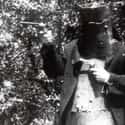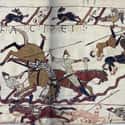-
(#12) Three-Quarters Of The World's First Feature-Length Film Got Blacklisted From History
There is a robust list of missing films from cinematic history, but arguably the most historically significant item was The Story of the Kelly Gang, a 1906 silent motion picture widely recognized as the world's first ever feature-length narrative film.
The Australian movie told the story of Ned Kelly and his mischievous crew, and it was a smash success despite its apparent runtime being over an hour long. Unfortunately, all records of the film became lost by the mid-1900s. In the decades since its disappearance, some fragments of the film have emerged, which adds up to about 25% of the entire movie; these parts are available for public viewing. The rest of the film remains lost.
-
(#2) Blackbeard's Treasure May Still Be Out There
Edward Teach, AKA Blackbeard, may have tight competition for the title of most famous pirate, but when it comes to pirate lore, his missing treasure is the most well-known piece of lost history. In 1718, Blackbeard and Queen Anne's Revenge supposedly ran aground on a sandbar in North Carolina; no one has ever found the enormous trove of treasure that the ship reportedly carried.
Since this incident neither rendered the ship unusable - and experts argue if this ship is indeed Queen Anne's Revenge - nor significantly impacted the people aboard it, the crew would have had more than enough time to unload and conceal their haul. As of 2018, there is no definitive find of Blackbeard's purported treasure.
-
(#7) The Third Reich Made The Amber Room Disappear
Some monarchs use stones and jewels to decorate their crowns and sceptres, but King Frederick I of Prussia took it a step further by having an entire room constructed from his favorite gemstone: amber. The bedazzled Amber Room came about in 1701, then 15 years later, King Frederick William I gifted the room to Peter the Great as a symbol of their newly cemented alliance.
The room comprised several large, removable panels, which could be transported with ease. However, this advantage quickly turned into a detriment when the Germans began Operation Barbarossa in 1941 and invaded Russia.
The Third Reich looted countless Russian treasures, including the Amber Room, which they sent to a castle museum in Königsberg, Germany. Some believe offensive strikes destroyed this German castle in 1944, presuming the Amber Room as lost. Rumors persist, however, that perhaps a group deconstructed the Amber Room once again and moved it to a secret location. Others believe the panels were loaded on to a steamer called the SS Karlsruhe for transport to Germany during the war, but Soviet planes took down the ship.
In 2020, Polish divers discovered the wreck of a ship called the Karlsruhe filled with crates that they believe might hold the amber panels. Tomasz Stachura, leader of the dive team that found the ship, told Live Science that "the possible examination of the load will have to be discussed with the Maritime Office in Gdynia, Poland, and they will make the final decision."
-
(#4) The Map Used To Plan The Atomic Event At Hiroshima Remains Lost
The atomic devices dropped by the United States on Hiroshima and Nagasaki altered world history forever, but the map used to plan the first offensive strike is currently gone. The document, titled Map of Target Area 90-30-748, Hiroshima Area, A-2 Section, XXI Bomber Command, is supposed to be in the National Archives, but it disappeared at an unknown date and has never been recovered.
For posterity's sake, however, a few copies of the map still exist.
-
(#1) No One Knows The Whereabouts Of The Bayeux Tapestry's Final Panels
The Bayeux Tapestry is one of the most recognizable treasures from the Middle Ages that still exists today. Reportedly created within a few years of the Battle of Hastings in 1066 CE, the lengthy narrative wall-hanging depicts William the Conqueror's invasion of England.
Uncovered in 1729, the tapestry spans 230 feet long, but it is missing its final scene, as evidenced by its frayed ending and lack of a narrative conclusion. While modern-day embroiderers have attempted to complete the story, the real final panels of the Bayeux Tapestry have never turned up.
-
(#3) Somebody Seemingly Took JFK's Brain
At some point between 1963 - the year when President John F. Kennedy passed - and 1966, JFK's brain - which medical professionals had removed during his autopsy - went missing from its storage place in the National Archives. Nobody can explain when, how, or why this happened.
Numerous conspiracies abound about this case, with one theory centering on JFK's brother, Robert Kennedy. Some believe Robert took the brain to hide evidence of the many supposed illnesses JFK was hiding from the public while he was in office.
New Random Displays Display All By Ranking
About This Tool
Our data comes from Ranker, If you want to participate in the ranking of items displayed on this page, please click here.






